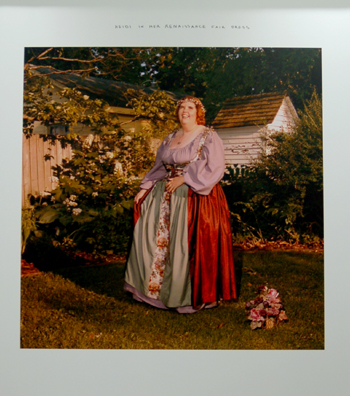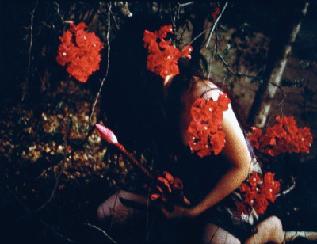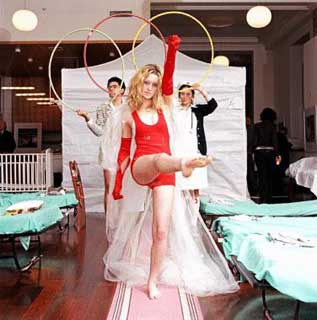
Detail from Chris Verene's "Heidi in Her Renaissance Fair Dress" 2004
Heidi greets you at the door, resplendent in her full regalia of "Ren" Fair attire, beaming in all of her medieval maiden glory. She seems relaxed and proud amidst suburban fauna and flora, the portrait of someone living as closely as possible to a dream. POW! Pictures of Women confronts you immediately upon entering the door. Enter here, stage left, Quality Pictures, Portland's latest addition to the Pearl, and after experiencing the raw caliber of its first show, quite an addition indeed.
"POW! Pictures of Women" and Chris Verene's "Self-Esteem" are gallerist Erik Schneider's poignant selection for Quality Picture's striking debut. As POW! leads one into QPCA's voluminous space, the air changes a bit. There is an air of earnest, spiritual ambition reminiscent of gothic architecture in not only the walls of the gallery but in the hanging of this show. The subject matter is one of the most difficult to take on as it is one of the most investigated subjects. Portraits, photographs, and general images of women abound and have populated the world for centuries. Such subjects are precarious and often touchy as they are the most hackneyed, surrounded and weighted by definitive stigmas. Ironically, this is the reason that Schneider chose to do this first show of women, deeming that most of us do indeed have and/or are exposed constantly to such images of the feminine form. It is for this reason that these images stand apart so stridently from their hackneyed counterparts. Often raw and intimate, often voided shells of imposed ideas of femininity, these works not only provide us with images of insight into the experiences and ideas of each artist, but they also ask questions of us as eager and respected viewers.
Here are our portraits: Hungry souls pulling up stockings, primping and pushing up breasts. Young girls don Brownie sashes as grown women entertain four inch high bangs. There are masked, whirling Victorian dervishes fueled by an empty female propriety that buttons up to the chin and continues to blossom on the lawns of the grandest colonial homes. Some of these women entertain parasitic looking growths inside of their mouths and earlobes and hang from chains around their throats. The most candid of the photos portray languor, longing, and a tangible unrest. Occasionally, pretty youths patiently await an unseen director's summons for the next scene on the set of a pornographic film as they emote to the still camera's lens with a wisdom beyond years or words. There are shots with legs spread and breasts bared. Rarely do the subjects openly inform the viewer about themselves or personaly thoughts, and when they do, it is in a sinister, almost menacing light, as women rebelling against relentless impositions. Kara Walker's "Emancipation Approximation" depicts lovely feminine silhoutte, bustiered and curlyqueued, languidly pondering seemingly pondering such taxing subjects as the atmosphere of dusk, meanwhile skirting the macabre footing of decapitated heads at her feet. Glenn Brown's untitled print of a Victorianesque woman also lurks on the tiny shore from this edge of the pond. Her magenta gaze seems to know something we do not.
What do they tell us about their subjects? Whom do I see? What defines femininity that is both not tangible and cannot also describe the physical properties of silk or milk or blood? Where do women exist when it is not in terms of flesh? In a time within which feminism often too has such a definitive stigma, portraying a strong female voice visually is often too easily dismissed. Suddenly that voice becomes part of a genre due to gender and much else is lost. Yet these images are riveting. We search for the people behind the stockings and bustiers that the photos are intending to roughly outline. They hint without a dogma, intending to imitate more life than creation.
Jenny Saville's work uses the notion of flesh-obsession to the extreme, gutting it up the middle, turning it inside out, documenting, and then painting the portrait of what we forget is our dripping form. Her photograph, "Closed Contact A" portrays a subject almost strangled by the girth of its own skin, conquered by the demise of that which is inescapable: one's self. Yet, she looks at you, directly, and suddenly the suffocating girth has spirit; it has life and suffering. This is one of the last images one sees before heading into the second section of the gallery, and suddenly the new portrait of woman becomes clear; it is stripped bare and raw, pared down to its essential form amidst obstacles of inescapable weight and undeniable form. There is a last visual imprint on the memory of magenta flowers and phallus from Naomi Fisher before heading into the next section of the gallery.

Naomi Fisher, "Untitled (Bougainvillaea)" 2001
A sultry extension of the portraits commences once again, only this time there is a completely different aura surrounding this new portrait. We are greeted quite confrontationally by a figure in fuchsia one-piece bathing suit, sensuously sucking on a Jumbo Jet Star, complete with manicured nails and five o'clock shadow. Schneider has thoughtfully juxtaposed this beginning of the "Self-Esteem" show with a portrait of what at first glance might be a woman, yet this portrait is immediately different. It is not imposed upon or manipulated at all. The figure acts of its own volition, confrontationally, more predator than prey. This is an expertly orchestrated transition between both shows as well as a perfect introduction to Verene's body of work. Many of the photographs in this collection derive from what Verene calls a "Self-Esteem Salon" wherein he invites volunteers to participate in a group meeting in which their fantasies and dreams will try (with the assistance of his staff) to become at least a little more of reality. Verene then documents this experience. From one photograph to the next, one would never guess this exact process has occurred. The overall impression is one of indulgence and fantasy, from the extravagant degree of nuance of props and characters to the eccentric yet poignat cameos of Verene's alter ego, Cheri Nevers. This delightful, if slightly confusing, indulgence extends down to the formalities of these photographs, their juicyfruit colors and occasional painty or circular edges contributing to the beauty of these hopeful enactments. There are obvious references to art history in the subject matter and compositions of these photographs, yet the overall impression is of an exultant freedom of form and expression. Verene seems to want to give the world the freedom he has to be completely and wholly themselves, to act upon dreams and impulses, and then documents it all as a reminder.

Chris Verene's "Olympics Fantasy (from the Orphanages Series of the Self Esteem Salon)" 2004
The juxtaposition of the two bodies of work seems a kaleidoscopic foil as POW! moves into "Self-Esteem" and vice versa. Schneider has hung this first two bodies of work with finesse and a high esteem for his viewers, and the experience is thus extremely engaging and thought provoking. It is a mouth watering appetizer for what is hopefully to come as this elegant new space nestles itself coquettishly in the heart of the vibrant Pearl.


















